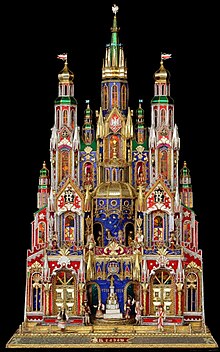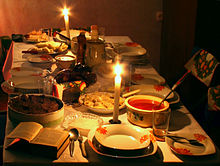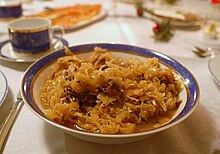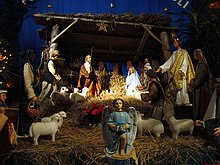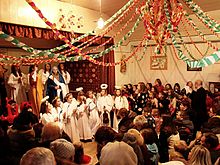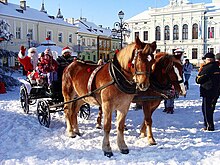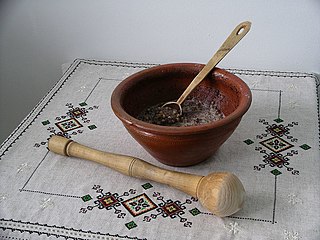
Kutia or kutya is a ceremonial grain dish with sweet gravy traditionally served mostly by Eastern Orthodox Christians and some Catholic Christians predominantly in Belarus, Russia, Ukraine, but also in parts of Lithuania and Poland during the Christmas – Feast of Jordan holiday season or as part of a funeral feast. The word with a descriptor is also used to describe the eves of Christmas, New Year, and Feast of Jordan days.

Christmas Eve is the evening or entire day before Christmas Day, the festival commemorating the birth of Jesus. Christmas Day is observed around the world, and Christmas Eve is widely observed as a full or partial holiday in anticipation of Christmas Day. Together, both days are considered one of the most culturally significant celebrations in Christendom and Western society.

In the Christian tradition, a nativity scene is the special exhibition, particularly during the Christmas season, of art objects representing the birth of Jesus. While the term "nativity scene" may be used of any representation of the very common subject of the Nativity of Jesus in art, it has a more specialized sense referring to seasonal displays, in particular sets of individual sculptural figures and props that are arranged for display.

Epiphany, or Eid al-Ghitas, also known as "Theophany" in Eastern Christian tradition, is a Christian feast day commemorating the visit of the Magi, the baptism of Jesus, and the wedding at Cana.

Christmas is one of the biggest holidays in the Philippines. As one of the two predominantly Catholic countries in Asia, the Philippines celebrates the world's longest Christmas season ; Christmas music is played as early as August. The holiday season gradually begins by September, reaching its peak in December during Christmastide, and concludes within the week after New Year's Day, more specifically on the Sunday of Epiphany; however, festivities could last until the third Sunday of January, the feast day of the Santo Niño de Cebú. Liturgically, the Christmas season is observed by the Catholic Church in the Philippines from Christmas Day to the Feast of the Baptism of the Lord.

The observance of Christmas around the world varies by country. The day of Christmas, and in some cases the day before and the day after, are recognized by many national governments and cultures worldwide, including in areas where Christianity is a minority religion. In some non-Christian areas, periods of former colonial rule introduced the celebration ; in others, Christian minorities or foreign cultural influences have led populations to observe the holiday.
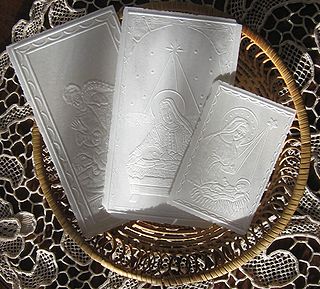
Christmas wafer is a Catholic Christmas tradition celebrated in Poland, Lithuania, Moravia, and Slovakia. The custom is traditionally observed during Kūčios in Lithuania and Wigilia in Poland on December 24.
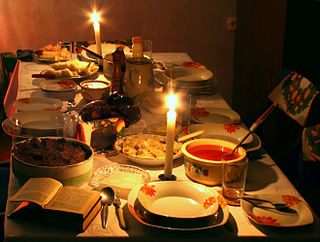
Wigilia is the traditional Christmas Eve vigil supper in Poland, held on December 24. The term is often applied to the whole of Christmas Eve, extending further to Pasterka—midnight Mass, held in Roman Catholic churches all over Poland and in Polish communities worldwide at or before midnight. The custom is sometimes referred to as "wieczerza" or "wieczerza wigilijna", in Old Polish meaning evening repast, linked to the late church service, Vespers from the Latin.

Pasterka is a midnight mass celebrated by Roman Catholics during Christmas between December 24 and 25 across Poland. A close translation of the name would be the "Shepherds' Mass", in reference to the Biblical shepherds, who were visited by an angel and told of the birth of Christ. During the Pasterka Mass, Polish people sing traditional kolędy, Christmas carols in the spirit of joy.

A twelve-dish Christmas Eve supper is traditionally prepared to commemorate Jesus' twelve disciples in Central, Northern and Eastern European cultures, especially those that were formerly part of the Polish–Lithuanian Commonwealth and neighbouring countries. The tradition is especially cultivated in modern-day Poland, where alternatively thirteen meatless dishes on Christmas Eve are sometimes served.
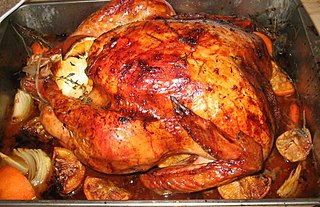
Christmas dinner is a meal traditionally eaten at Christmas. This meal can take place any time from the evening of Christmas Eve to the evening of Christmas Day itself. The meals are often particularly rich and substantial, in the tradition of the Christian feast day celebration, and form a significant part of gatherings held to celebrate the arrival of Christmastide. In many cases, there is a ritual element to the meal related to the religious celebration, such as the saying of grace.

Kūčios or Kūtės is the traditional Christmas Eve dinner in Lithuania, held on December 24. The meal is a family occasion which includes many traditions of both pagan and Christian origin. Some traditions are no longer widespread and usually Lithuanians just enjoy dinner with relatives and friends while the main events and festivities are left for Christmas Day.
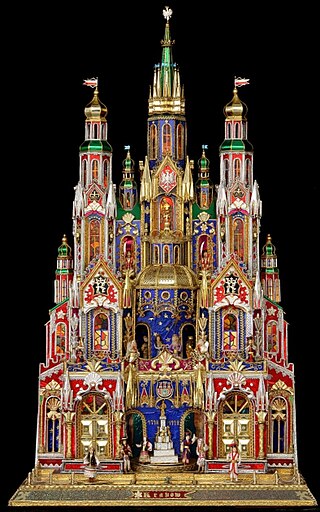
Kraków szopki or nativity scenes are a Christmas tradition originating from Kraków, Poland, and dating back to the 19th century. An unusual and characteristic feature of the szopka is the use of historical buildings of Kraków as a backdrop for the Nativity of Jesus. In 2018, it was inscribed on the list of UNESCO Intangible Cultural Heritage of Humanity.

In Ukraine, Christmas celebrations traditionally start on Christmas Eve, which is celebrated from December 24 to January 6, the date of the celebration of the baptism of Jesus, known in Ukraine as Vodokhreshche or Yordan, according to the Gregorian calendar and Revised Julian calendar by the Orthodox Church of Ukraine (OCU), the Catholic Church in Ukraine and Ukrainian Protestants.

Christmas in Hungary is celebrated with traditions similar to those found in other Central European countries as well as customs unique to the region.

Christmas in Mexico is observed from December 12 to January 6, with one additional celebration on February 2. Traditional decorations displayed on this holiday include nativity scenes, poinsettias, and Christmas trees. The season begins with celebrations related to the Virgin of Guadalupe, the Patroness of Mexico, followed by traditions such as Las Posadas and Pastorelas.
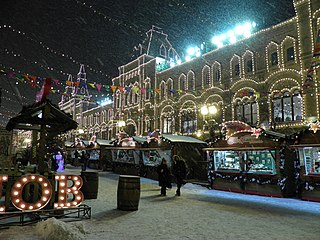
Christmas in Russia, called Е́же по пло́ти Рождество Господа Бога и Спа́са нашего Иисуса Христа in the Russian Orthodox Church, is a holiday commemorating the birth of Jesus Christ. It is celebrated on the 25th of December on the Julian calendar, which corresponds to 7th of January on the Gregorian calendar. It is considered a high holiday by the church, one of the 12 Great Feasts, and one of only four of which are preceded by a period of fasting. Traditional Russian Christmas festivities start on Christmas Eve, which is celebrated on 6 January [O.S. 24 December].

Christmas traditions include a variety of customs, religious practices, rituals, and folklore associated with the celebration of Christmas. Many of these traditions vary by country or region, while others are practiced virtually identically worldwide.

Podłaźniczka, polazňička is Polish and Slovakian Christmas decoration. It was usually made of the top of a conifer tree turned upside down, which was then decorated with tissue paper, candies, apples, nuts, typical Polish świats, or of straw. This decoration was then hung over the Vigil table or in a corner. It was supposed to bring luck and prosperity to the household. Podłaźniczka originates from the tradition of połaźnik.
